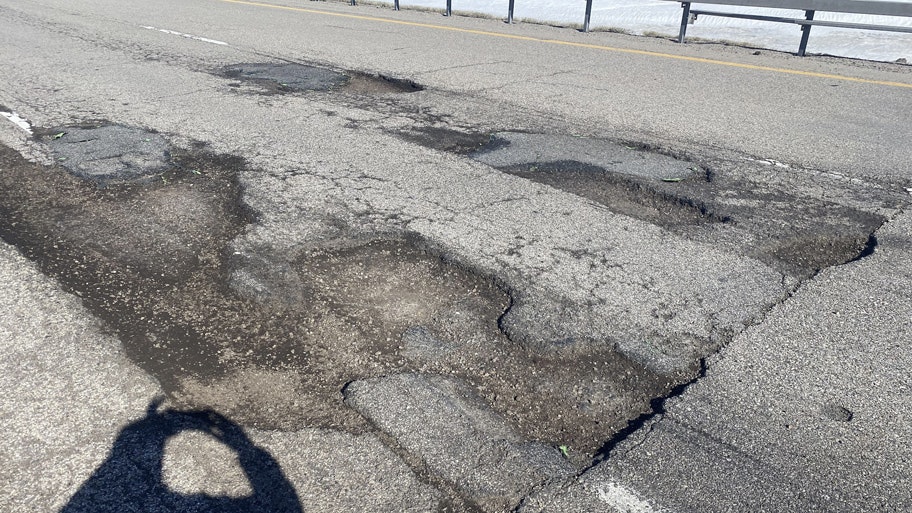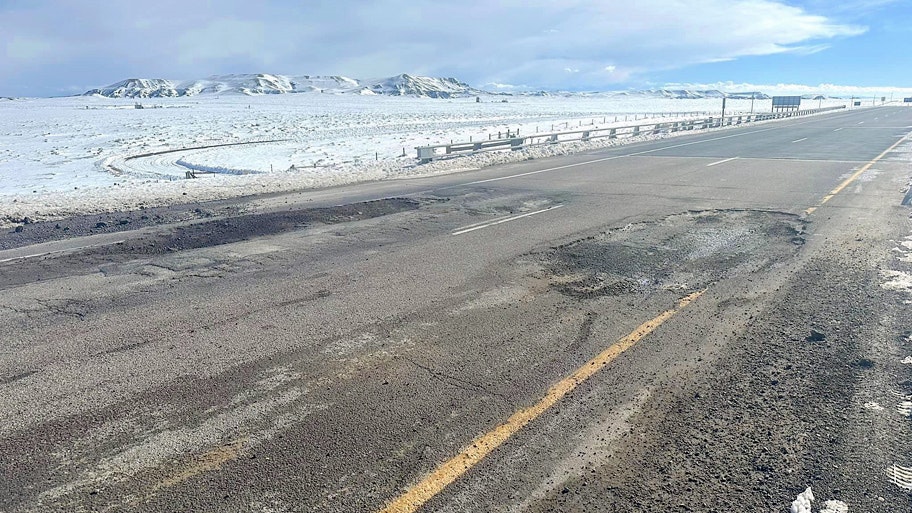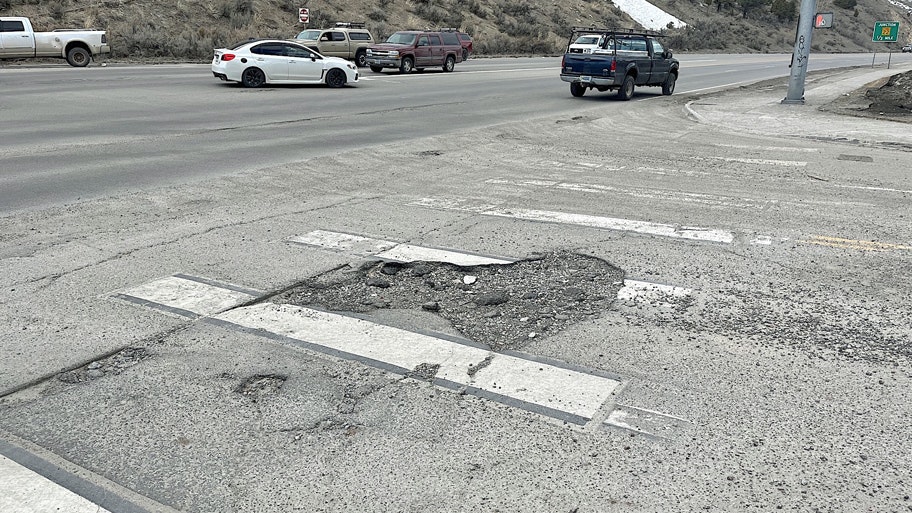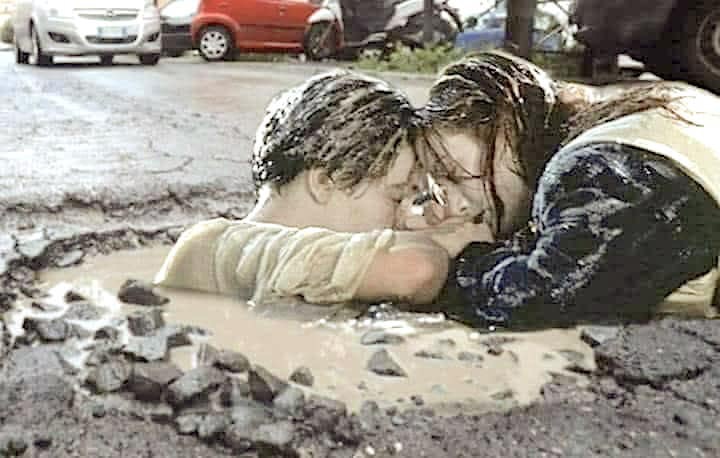Potholes are something of a rite of spring in Wyoming. They have their own season (we are currently in the heart of “pothole season” right now), and some of the larger ones boast their own ecosystems.
Owed to an extreme freeze-thaw cycle, Wyoming is a breeding ground for those bothersome roadway divots that can cause motorists to appear inebriated trying to dodge them.
Ranging from nuisance cracks to soul-crushing, tie-rod warping ponds, potholes are a bother to drivers and a never-ending headache for public works departments and highway maintenance crews.
A quick survey of communities across Wyoming found pothole season to be in full swing, and one of the more challenging spring seasons ever.
Trying to get to every reported pothole with limited budgets and undermanned departments is not always easy. The temptation to DIY is real.
Occasionally, neighborhood vigilantes like former California governor Arnold Schwarzenegger might even take it upon themselves to fix a perceived road hazard. (More on that later).
Highway From Hell
What a winter it was for the Wyoming Department of Transportation. Their plow drivers deserve some sort of medal for simply surviving the snow season.
Interstate 80, for instance, felt like it was closed more than it was open. Now, with snow (almost) in the rearview mirror, it’s time for WYDOT to turn its attention toward highway repair. There’s enough on I-80 alone to keep the department busy for quite some time.
“Perfect timing that you called about potholes,” said WYDOT’s PR person Stephanie Harsha when she took our call while driving the interstate in the Wamsutter area. “I'm on a pothole tour right now with our district maintenance technician in the car.”
“Is it bad?” we asked.
“I don't know if it’s the worst ever, but it is especially bad in the southwest part of the state, which is my district,” Harsha said. “We have our contracts out early, and just ordered more fill. We typically order about 30 tons to get us through the season. That’s already gone. We are probably looking at another 15 tons.”
Harsha said a combination of things contribute toward pounding Wyoming’s highways from pristine into surface of the moon. Moisture seeping into cracks and then freezing causes frost heaves or worse. That, combined with an increase in traffic on state highways—particularly heavier semi-tractor trailers—creates a perfect crater cocktail.
And it certainly doesn’t help that the department has complained about being underfunded for years. WYDOT’s six-year State Transit Improvement Plan (STIP) might be as ambitious as it is unrealistic. Crew availability and funding drives every decision the department makes, Harsha said.
For now, WYDOT triages highway repair and maintenance by safety. Roadways like I-80 that carry the most volume at the highest speeds are priority one. Next is severity of damage.
As for anyone inclined to take matters into their own shovels as Schwarzenegger did, Harsha issued a strong deterrent.
“No, please, absolutely not,” Harsha said. “It is quite dangerous on the interstate even for our guys. Not to mention filling takes a certain kind of material. Yeah, no, just don’t.”
Leave It To The Professionals
Schwarzenegger made news recently when he took it upon himself to mitigate a pothole in his neighborhood of Mandeville Canyon, a small community in the Brentwood area of Los Angeles.
After all, Schwarzenegger is obviously comfortable in the role of superhero from his film work and bodybuilding background, and he was governor of the state of California from 2003-2011. This is a guy who knows how to get things done.
Schwarzenegger enjoyed about two days of self-congratulation before the City of Los Angeles informed local media that the “pothole” was actually a service trench in active use by SoCal Gas, a local utility working on a project with an expected completion date of May.
Oops.
Plus, the bitumen filler used by Schwarzenegger is not suitable material for concrete roads like the one in question, says LA public works.
Double oops.
News of the Terminator’s faux pas made it all the way across the pond. Glasgow Times in the UK reported that during a city council meeting someone suggested getting Arnold to fill the numerous potholes plaguing the city.
A Glasgow authority responded: “We understand why a movie legend maintaining a road surface has attracted attention, but this is not a course of action we can support in Glasgow. Anyone undertaking such work without the proper authority can be fined or become liable for any damage caused by their repair. We’ll be sure to tell Mr. Schwarzenegger about this the next time we see him.”
Authorities in Sedan, Kansas had a similar response when some do-gooder gardeners filled several potholes with planted flowers. The Sedan Police Department had a sense of humor about it, writing up a funny police blotter about the incident before gently admonishing the green-thumbed culprits.
“Seriously though, we absolutely get the humor in your prank, but the only people you're hurting are the city employees who have the laborious task of cleaning out the holes so they can be patched,” cops stated.
Pothole USA
Across the nation, various municipalities are undertaking the daunting task of dealing with road damage from winter.
Baltimore Mayor Brandon Scott announced his city’s Build Better More Spring City Services Blitz—a 90-day campaign dedicated to erasing graffiti and filling some 9,000 potholes.
Not to be outdone, Salt Lake City Mayor Erin Mendenhall kicked off a weeklong initiative dubbed Pothole Palooza earlier this week—a massive undertaking to finish repairing over 30,000 potholes throughout the city.
“We are coming out of an intense winter season, and our city streets are showing wear like many of us haven’t seen before from snow, salt, snowplows, and extreme temperature changes. Pothole Palooza is our effort to have a big impact in a short time frame and noticeably improve city streets right away,” Mendenhall said.
In Michigan, potholes are par for the course. The state consistently ranks at or near the top in worst states for potholes.
The Michigan Department of Transportation spokesperson Tim Fischer stated Michigan spends about $7 million a year to fill some 400,000 potholes. That’s in addition to the ones fixed by counties and local communities.
In Jackson (Pot)Hole
Each municipality in Wyoming has their own way of dealing with potholes.
In Jackson, Sam Jewison heads the streets division of public works. He’s been on the job since 2009 and says he can’t recall a season this bad.
“You up to your eyeballs in potholes, Sam” we asked.
“Literally? Maybe not that deep but there are a few around town that are close,” Jewison joked. “I was surprised. I think we all were surprised. We thought we were going into fall with the roads in pretty good shape. It’s been a tough, long winter.”
Potholes in Jackson have surpassed years past in both quantity and quality. Jewison said some of the deeper ones have eaten clear through two inches of asphalt all the way to the sub-base.
Jewison admitted he heard about the “Schwarzenegger deal,” and discouraged the notion.
“If someone takes it upon themselves it’s going to be extremely temporary and not a long-term solution. We’ve seen people putting washed rock in holes in the alleys, for instance. We just have to get rid of all that fill and use the right method,” Jewison said. “I would rather not have the average citizen take it upon themselves.”
Around the state
In Casper, Shad Rogers heads the streets division. He’s got four crews running to make repairs on an average of 90,000 square feet of potholes and curb cuts.
“It’s hard to gauge year to year but we are seeing bigger ones this spring,” Rogers said. “I’ve got two patch trucks on both sides of town. We’ve already done thousands. We’re staying ahead of it I would say.”
They don't mess around in Riverton where a special task force is in place with funding from a 1% specific excise tax authorized by voters. Fix Our Roads Citizens Committee (FORCC) keeps public works director Brian Eggleston on speed dial.
“This has been an odd weather year with unusually high amounts of snow and cold temperatures. Now, we can see the aftermath of the winter season with the plethora of potholes and other distressed asphalt conditions,” Eggleston stated on the city’s website.
Two crews have done nothing but cold-patching potholes since March 24 until more permanent hot asphalt can be poured when daytime temperatures warm up more.
Sheridan’s streets services supervisor Neal Holcomb said his crews also use the “throw-and-go” method of cold patching until temps warm.
Pothole hotlines
Some towns even have a dedicated report-a-pothole hotline or online form.
Connect Sheridan is a mobile app that directly links citizens with city departments like public works. Chief of the Sheridan Police Department Travis Koltiska said he understands motorists’ complaints about vehicle damage resulting from hitting a pothole, and the city is doing all it can to improve road conditions.
Lander also has an online pothole repair request form that has seen heavy use of late, according to public works head Lance Hopkin.
Cody streets superintendent Rob Kramer admitted his city has “its fair share of potholes because of all the moisture.” But he says his department is keeping up with it using a bagged pothole patch material. “It’s not been too bad,” he added.
Larry Joubert in Buffalo has been swamped. Worst he’s seen in 30 years on the job.
“We totally lost some streets,” Jaubert said. “They were newer streets without a lot of asphalt on them. We’ll have to start from scratch on those.”
Joubert laughed when he learned of the Schwarzenegger story. He was the only person we contacted who had not heard of it.
“We’ve got a few of them around here that do it themselves. They know we have a small crew in Buffalo. I had a guy come in the other day and get six buckets of gravel. I didn’t ask what for. It will last for a while. Until we can get to it.”
Pricey potholes
In theory, some states, counties, and insurance companies offer reimbursement programs for vehicle damage caused by deteriorated roads. In reality, it’s almost impossible to get compensated.
And expenses add up.
National Transportation Research, a nonprofit crunching the numbers every year, estimates 40% of major roads in the U.S. are in poor or mediocre condition. Driving on deteriorated roads costs motorists $141 billion a year—$621 per driver—in the form of additional repairs, accelerated vehicle depreciation, and increased fuel consumption and tire wear.
Another study by American Automobile Association (AAA) puts the annual associated costs directly deriving from potholes at more like $3B, citing damage ranging from popped tires and wrecked rims to ruined exhaust systems and alignment issues.
The average repair bill associated with a pothole mishap is $306, according to AAA. Triple A also estimates 1 in 10 drivers in the U.S. damaged their car in 2021 after running over a pothole.











